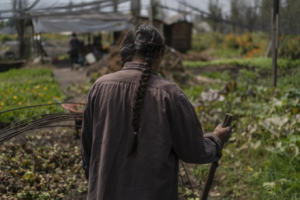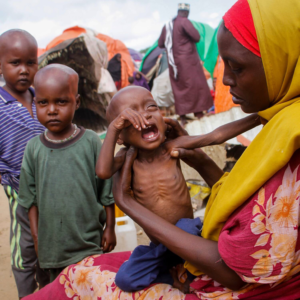The U.S. could have hundreds of thousands of fewer births next year than it would have in the absence of a pandemic.
Updated at 9:10 a.m. ET on November 25, 2020.
By now, the pandemic has disrupted Americans’ daily lives for nearly as long as a baby typically spends in the womb. This means that many children conceived in mid-March are weeks away from joining us in this disorienting new world, but just as notable are the children who won’t be joining us—the babies who would have been born were it not for the ongoing economic and public-health crises. These missing births, which could end up numbering in the hundreds of thousands in the U.S., will make up what’s been called the “COVID baby bust.”
One would think that a baby bust would take at least nine months to reveal itself, but traces of one seem to have already appeared. As Philip Cohen, a sociologist at the University of Maryland, has noted, births started to decline in California and Florida during the summer. That’d be too soon, though, to reflect a drop in conceptions during the pandemic, or a rise in abortions or miscarriages (which tend to happen earlier on in pregnancy). Three possible explanations, Cohen told me, are errors or lags in states’ data on births, large numbers of pregnant people moving during the pandemic and giving birth in another state, or a large, unexpected drop-off in births that was already going to happen regardless of the pandemic.
The first is probably incorrect—California and Florida’s health departments told me that they weren’t aware of any delays in reporting data. The second is possible, but a little hard to believe. Cohen thinks the third is likeliest. “It might actually be that we were already heading for a record drop in births this year,” he said. “If that’s the case, then birth rates in 2021 are probably going to be even more shockingly low.”
[Read: ‘We’re talking about more than half a million people missing from the U.S. population’]
The baby bust isn’t expected to begin in earnest until December. And it could take a bit longer than that, Sarah Hayford, a sociologist at Ohio State University, told me, if parents-to-be didn’t adjust their plans in response to the pandemic immediately back in March, when its duration wasn’t widely apparent.
The resulting decline in births, whenever it kicks in, could be quite large. In June, the economists Melissa Kearney and Phillip Levine projected that 300,000 to 500,000 fewer babies might be born in 2021 than there would have been otherwise. “We see no reason to think that our estimate was too large at this point,” Kearney told me five months after the analysis was published. “In fact, given the ongoing stress for current parents associated with school closures, the effect might even be larger than what we predicted.”
Kearney and Levine’s estimate is based in part on the declines in birth rates that occurred as a result of past crises, such as the 1918–19 influenza pandemic and, more recently, the Great Recession. But as the two economists note, the coronavirus pandemic is a departure from historical precedents. The influenza pandemic wasn’t an economic crisis and the Great Recession wasn’t a public-health crisis, so it might be difficult to accurately predict the effects of a disaster that mixes elements of both.
Researchers have also tried other forecasting methods that don’t rely on what happened after previous catastrophes. One analysis is based on the volume of Google searches for pregnancy- and unemployment-related terms from earlier this year. It projects a roughly 15 percent drop-off from this month until February, while Kearney and Levine’s prediction is a decline of about 10 to 13 percent over the course of 2021.
The accuracy of guesses like these should start to become clear next year; while national data for late 2020 won’t be available until mid-2021, some state-level analyses might arrive before then. But regardless of the baby bust’s exact size, it would be surprising if a significant one doesn’t come to pass. The phrase baby bust might imply that the nation is in danger of declaring newborn bankruptcy, but even if 500,000 fewer babies arrive next year than last, more than 3 million will still be born in 2021. Even a large decline in births shouldn’t have a significant long-term effect on America’s overall population size, given that tens of millions of babies are expected to be born this decade. (Meanwhile, in some countries, the pandemic might produce a spike in births, because of reduced access to contraception.)
It’s not just that fewer babies will be born—it’s also that different babies will likely be born, to different parents. As I wrote in July, white parents and parents with more resources might be better able to go through with their pre-pandemic childbirth plans than parents of color and parents with fewer resources, such as those who have lost earnings or jobs during the pandemic. In addition, the proportion of births that are “unintended” (whether planned for later or not wanted at all) may rise.
The children of the baby bust may even have some small advantages, by virtue of having a reduced pool of peers nationwide. They could have slightly smaller class sizes growing up, as well as a slightly easier time getting into college or landing a good job.
It doesn’t necessarily follow, though, that kids born in 2022 and beyond will have overcrowded classrooms and unusually stiff labor-market competition; the experts I consulted did not expect every missed birth next year to be made up down the line. “Some women will age out of fertility, but even for those who don’t, many couples are likely to experience persistent earnings and income loss on account of this economic crisis,” Kearney explained. “That will mean fewer babies born ever, not just this year.”
Researchers, however, are not expecting a post-pandemic baby boom to follow this bust.
There is a precedent, after some events with high or highly publicized death tolls, for birth rates to eventually rise above a previous baseline. For instance, researchers have documented localized increases in births for five years after the 2004 Indian Ocean tsunami in Indonesia (which killed around 200,000 people in the country) and the 1995 Oklahoma City bombing (which killed 168 people). And, famously, baby booms have often followed wars.
These patterns arose for different reasons. In Indonesia, many children and women of childbearing age died, and the rise in fertility “reflected the formation of new unions and the rebuilding of families in the disaster’s aftermath,” says Jenna Nobles, a sociologist at the University of Wisconsin at Madison who has studied the tsunami’s effects. In Oklahoma, the explanation was not as straightforward; Joe Rodgers, a psychology professor at Vanderbilt University who researched the effects of the bombing, theorizes that the extra births could have been the result of a combination of increased community solidarity, a renewed appreciation for the fragility of life, and a sharper focus on the meaningfulness of family. And after a war, explains the UCLA sociologist Patrick Heuveline, a spike in births can result simply from soldiers coming home and reuniting with their partners en masse.
Though COVID-19’s death toll in the U.S. is huge—some 250,000 and counting—the pandemic’s multifaceted nature and distribution of deaths (which have been concentrated among older Americans) distinguish it from those events. “This crisis is not just sending ripples of loss across American families. It’s also an economic crisis, a child-care crisis for parents, an upending of our social institutions and way of life, and of course an ongoing public-health threat,” Emily Smith-Greenaway, a sociologist at the University of Southern California, told me. “I increasingly doubt that this crisis is being experienced principally as a mortality shock.”
Birth rates should, however, rebound to roughly pre-pandemic levels sometime after the threat of COVID-19 subsides—that’s what happened not too long after other disasters, such as the 2003 SARS outbreak in Hong Kong and Hurricane Katrina in Louisiana in 2005. At the same time, identifying a full return to “normal” birth rates could be tricky because, as Hayford noted, “Even before the pandemic, it was kind of not clear what trajectory we were on.”
Any rebound will probably unfold incrementally, as different sectors of society recover. “Even for women or couples who will eventually make up for their lost conceptions, the catch-up will not happen all at once, because the resolution of the crisis will be gradual,” says Tom Vogl, a development economist at UC San Diego. Like the pandemic itself, the upcoming baby bust likely won’t end at a distinct moment in time, but rather little by little.




